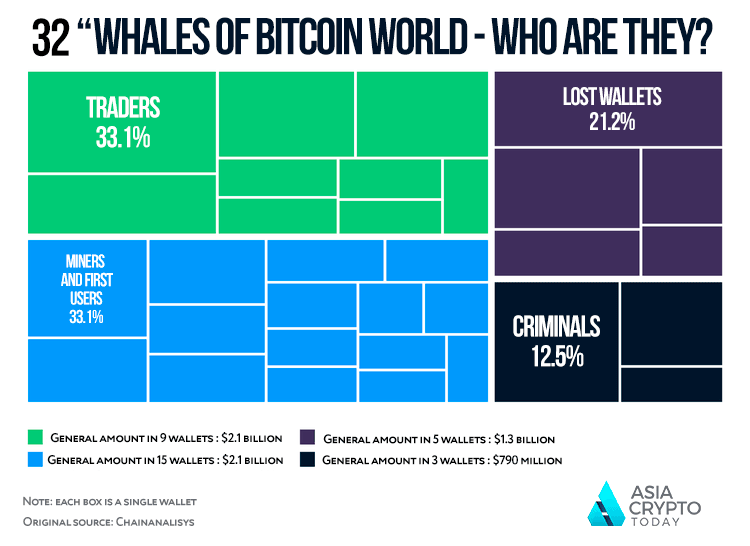In the Bitcoin world, mysterious “whales” are often discussed as the investors who own huge amounts of cryptocurrency. Now, thanks to the research of the crypto analytical company Chainalysis we have learned a lot about who they are and how they affect the market.
The subject of the study was the 32 largest “whales”. The cumulative condition of which is just over 1 million bitcoins (Bitcoin) – out of 17 million, which are naming today. The smallest “whale” holds about 12 thousand bitcoins, and the largest – 85 thousand bitcoins. At current prices, these are about $ 75 million and $ 541 million, respectively.

As the infographic shows, 32 “whales” were divided into four categories:
Criminal. It includes three “whales” who made a fortune a few years ago when Bitcoin was known mainly as the currency for conducting illegal operations. Chainalysis suspects that one of these “whales” is in prison.
Traders. However, investors are probably more interested this category, consisting of nine users who entered the market in 2017 and actively trade in cryptocurrency. According to economist Kim Grauer (and contrary to popular belief), these “whales” mostly act as buyers when the cryptocurrency falls, and there is no evidence that they act together.
Thus, the widespread belief that “whales” manipulate prices is not confirmed. It is also clear that there are relatively few traders among the “whales” – by the way, three of them operate only on Asian exchanges. Many Bitcoin wallets, which appear in the rich lists on the Internet and become the subject of discussion by amateurs, have nothing to do with the “whales” – these are the wallets of stock exchanges and other commercial organizations.
Miners and first users. The other two categories of “whales” are even smaller. There are miners who have accumulated a lot of Bitcoins, when mining was simple and inexpensive (although they may have gotten them in some other way) – Chainalysis says that such users sell parts of their stocks, but rarely, and in the long run the group tends to hold its assets.
Lost wallets. Five “lost whales” are people who in the early period of the network accumulated a lot of Bitcoins, but then either died or lost their keys – judging by the complete lack of activity in the wallet. The study showed that almost 4 million Bitcoins were irretrievably lost, for a total of 21 million coins. Chainalysis didn’t just find the biggest wallets to define the “whales” – the researchers used what they call the “cost sharing analysis”, which allowed them to find clusters of purses that belong to one person.
Grauer says that such a study has an important limitation: it should be assumed that some “whales” are smart enough to avoid actions that can be interpreted as shared expenses. In addition, the study does not feature the largest “whale”: the founder of Bitcoin, known under the pseudonym Satoshi Nakamoto. His condition, scattered across many wallets, is more than 1 million Bitcoins, and Chainalysis suggests that they are forever lost.
What conclusions can be drawn here?
We tend to exaggerate the whales’ market power. The 32 largest “whales” control about 6% of the cryptocurrency supply, and if you subtract lost coins from here, this figure will drop to 4.6%. It is also important that only a few of these “whales” show regular activity, and when they act, they tend to support the price of bitcoin rather than lower it.



















